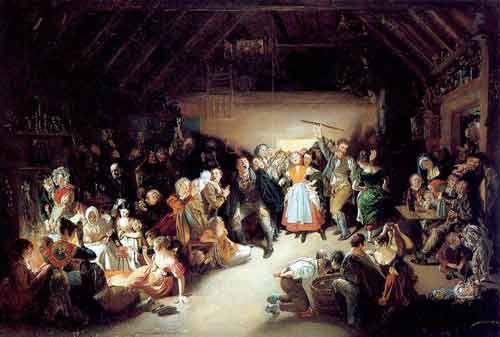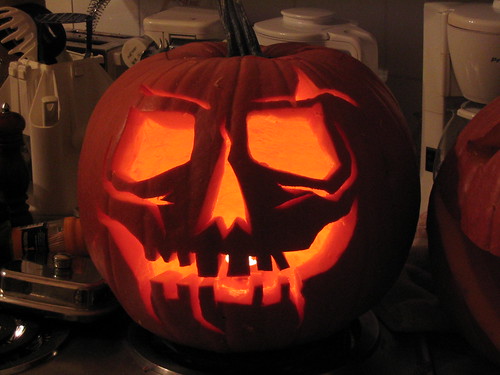Snap-Apple Night, was painted by Irish artist Daniel Maclise in 1833. Supposedly he painted this after attending a Halloween party in Blarney, Ireland, in 1832. The group on the left are playing divination games. The group in the middle are playing “Snap Apple”, a game where an apple dangles from a string and people, with their arms tied behind their back, try to bite the apple. The first person who bites the coin in the apple wins. The group on the right are bobbing for apples.
From the caption in the first exhibit catalogue:
There Peggy was dancing with Dan
While Maureen the lead was melting,
To prove how their fortunes ran
With the Cards ould Nancy dealt in;
There was Kate, and her sweet-heart Will,
In nuts their true-love burning,
And poor Norah, though smiling still
She’d missed the snap-apple turning.
On the Festival of Hallow Eve.
Halloween is a great tradition, born in Europe and celebrated all across the world. Falling between Autumn Equinox and Winter Solstice, Halloween is significant in many ways, most notably as it marks the change in the seasons from the brightness of Summer and Fall into the darkness of Winter. It is also a chance to reflect on our departed ancestors.
While many people may be distracted by the Halloween costumes and candy sold in department stores, the origins of Halloween come from traditional celebrations in European countries. In Ireland, Halloween was called Samhain, from the Gaelic for “End of Summer”. This event was a pastoral and agricultural festival and feast that allowed for the recognition of the coming of winter, thanks for the fall harvest, and reflections on their ancestors. Halloween has also long been celebrated in the UK, as noted in the Robert Burns poem “Halloween“, from 1785:
Upon that night, when fairies light
On Cassilis Downans dance,
Or owre the lays, in splendid blaze,
On sprightly coursers prance;
Or for Colean the rout is ta’en,
Beneath the moon’s pale beams;
There, up the Cove, to stray an’ rove,
Amang the rocks and streams
To sport that night;
Amang the bonie winding banks,
Where Doon rins , wimplin , clear;
Where Bruce ance rul’d the martial ranks,
An’ shook his Carrick spear;
Some merry, friendly, countra-folks
Together did convene,
To burn their nits , an’ pou their stocks ,
An’ haud their Halloween
Fu’ blythe that night.
Many other countries in Europe celebrate the traditional customs of Halloween under festivals of different names. For example, the Roman Catholic Church moved All Souls Day to the time of Halloween in order to put a Christian spin on a traditional Heathen festival (as the church has also tried to do with Yule/Christmas and Easter). And the traditional Halloween festival is also known as All Saints Day in England, Portugal, Spain, and Mexico. St. Martin’s Day, Allerheiligen, and Martinmas are also names associated with the Halloween tradition.
In Scotland they hollow out turnips to use as lanterns, bob for apples, and make Dirge Loaves out of oat flour to keep the souls of the dead safe. In Ireland, there lived a man named “Stingy Jack” who was so mean that we couldn’t get into Heaven or Hell, and so was forced to walk the earth for eternity carrying a turnip candle with an ember from Hell inside. Today, we carve Jack O’Lanterns to ward off the ghost of Stingy Jack.
From Italy, here is a recipe for Fave dei Morti, or Ossa dei Morti (bones of the dead), which is a type of cookie made with pine nuts, almonds, spices, flour, and sugar, and baked in commemoration of the dead. This tradition and cookie is thought to have originated from the Roman indigenous religious traditions, and co-opted by the Catholic church.
Even Japan has a festival, called o-bon (pronounced like “oh bone”) where the spirits of their ancestors are invited back into the homes–in rural areas they even sweep a path from the gravesites to the home, where the spirits are welcomed with ‘welcoming fires’. There are also dances and other festivities, as well as getting together with family. So while it may not be called “Halloween” in Japan, the spirit of the tradition is very similar.
Most countries have strong spiritual traditions that recognize that, during certain times of the year, the “veil” between our world and other worlds, between this life and the afterlife, becomes very thin, allowing for certain, um, transitions, and sometimes disturbances, to occur. During those certain times of the year we are more apt to hear the floor creak unexpectedly, or see something out of the corner of our eye. Or we might even get an unexpected chill when walking outside at night. It could be a departed ancestor trying to reach across the veil to a family member, or it could be something else entirely…
So have a Happy Halloween, eat a candy apple, drink some cider, bob for apples, wear a crazy costume, think of your ancestors, protect yourself from Stingy Jack, and prepare for the coming Winter.
Oh, and don’t forget to say “BOO!”.


